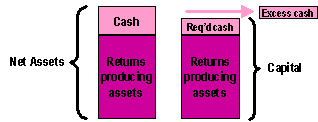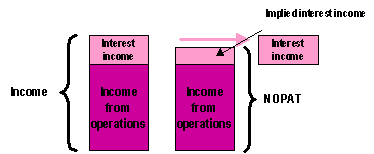Option 3: Exclude Only "Excess Cash"
We can estimate the amount of cash necessary to operate the company and hold managers accountable only for that level of cash. This option would presumably only apply to a business unit with no control over its nominal cash balances.
 This treatment has
three steps. First, a determination is made about the level of
"required" cash, and only that level is attributed to net
assets of the business unit. All actual cash amounts in excess of
"required" cash (or, conceivably, short of it) would be
subtracted from net assets so it doesn't affect the business units
capital.
This treatment has
three steps. First, a determination is made about the level of
"required" cash, and only that level is attributed to net
assets of the business unit. All actual cash amounts in excess of
"required" cash (or, conceivably, short of it) would be
subtracted from net assets so it doesn't affect the business units
capital.
 Second, this
required cash balance would be used to calculate an implied interest
income on that required cash amount. This would be computed using
the amount of required cash times the percentage return on short-term
notes. Third, total interest income attributable to cash would be
subtracted from income and replaced with the above calculate implied
interest income.
Second, this
required cash balance would be used to calculate an implied interest
income on that required cash amount. This would be computed using
the amount of required cash times the percentage return on short-term
notes. Third, total interest income attributable to cash would be
subtracted from income and replaced with the above calculate implied
interest income.
A more difficult determination is the implied interest income on that cash. We still have the consideration of segregating interest income associated with cash balances that dogged us in the prior treatment. Now, we must take that amount one step further and subtract an implied level of interest income on the "required" level of cash. The difference between the implied interest and actual interest attributable to cash balances (i.e., "excess interest income") would be added back to income. Rather than incur the cost of calculating and tracking this excess income, management may decide to simply ignore all interest on cash and revert to the all-or-nothing methodology discussed in the prior treatment.
Whatever the excess cash or excess interest turns out to be, these figures do not have to be tracked at the corporate level since all cash and all interest income would normally appear in corporate EP.
Benefits and Drawbacks
The benefits of this treatment include a more accurate measure of the cash requirements at the business unit level while largely separating the operating versus financing implications of cash. When cash is compiled for unusual reasons (e.g., large stock repurchases), business unit EVA would remain unaffected.
The main drawback to this treatment is its relative complexity in establishing and tracking "excess cash" and "excess interest income," the latter being particularly troublesome. Most of that complexity can be eliminated by subtracting from income all interest income attributable to cash (or all interest income, if other sources of that income are not large or are also excluded from net assets).
This would result in a slight penalty for management as it grows the business, with cash growing and no offsetting growth in income. But this effect would be minor on cash balances as low as a couple percent of sales.